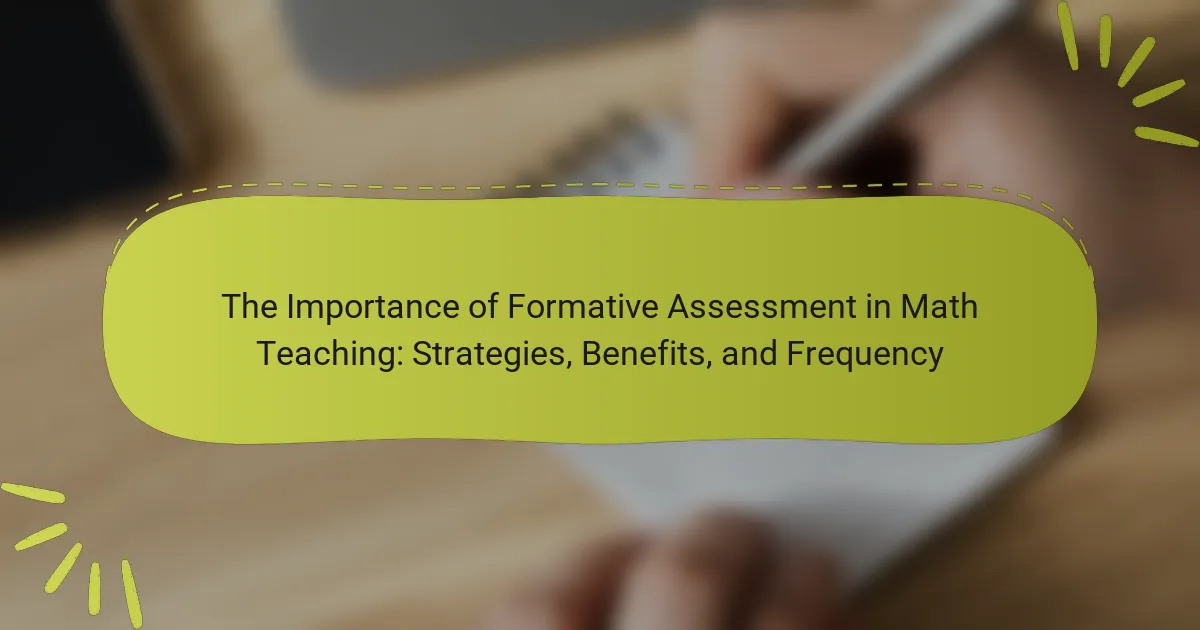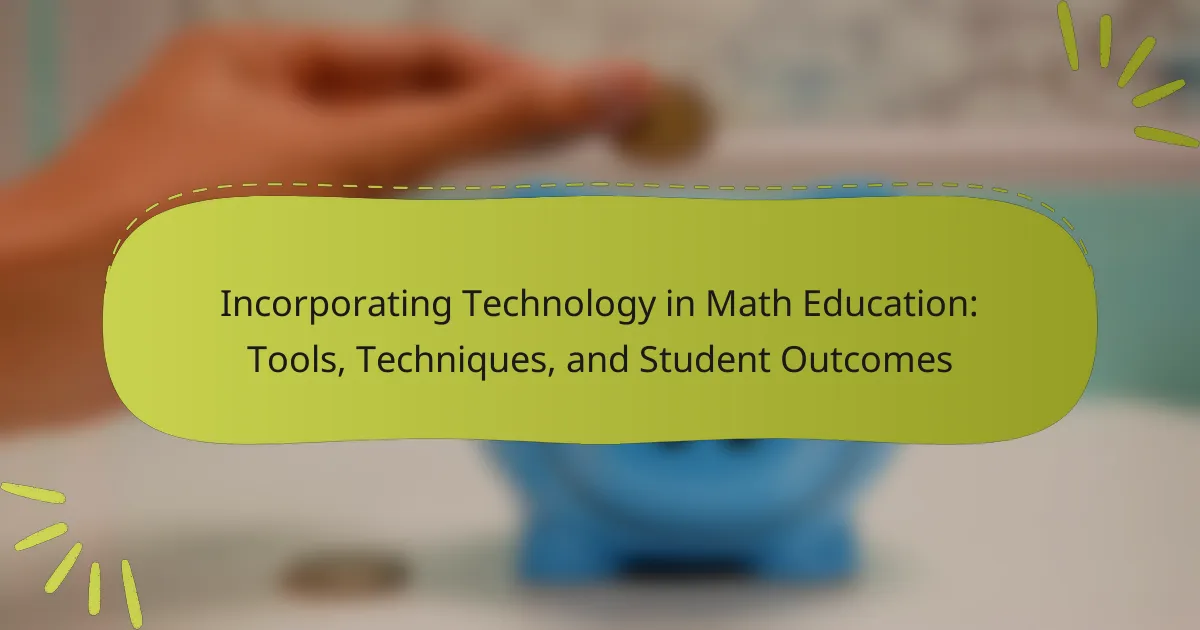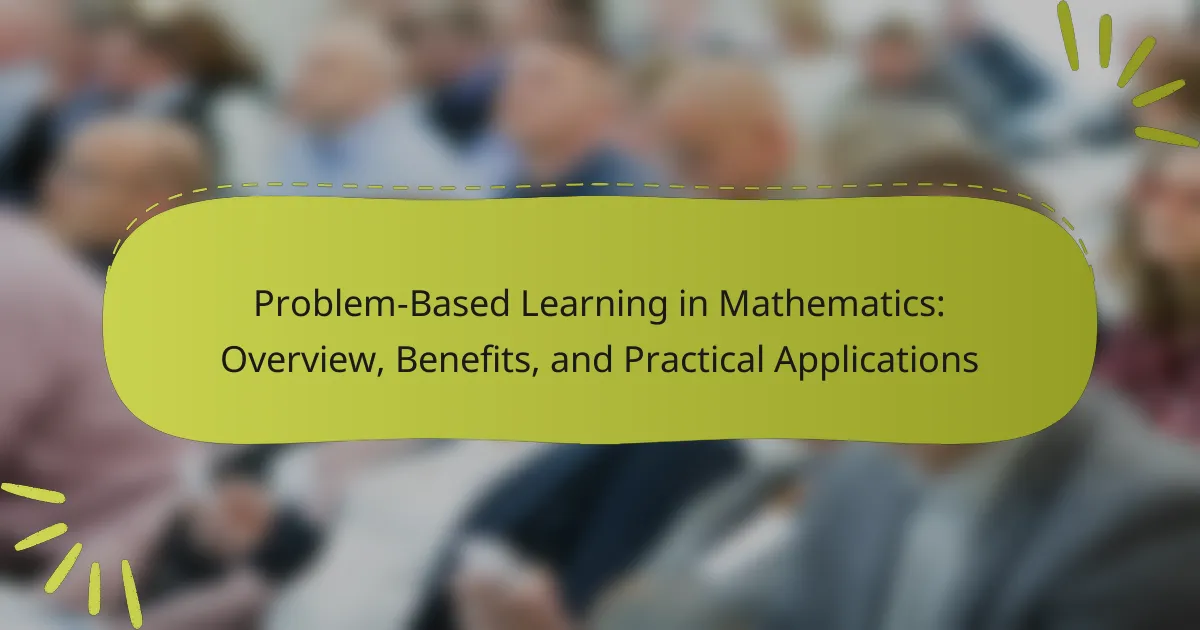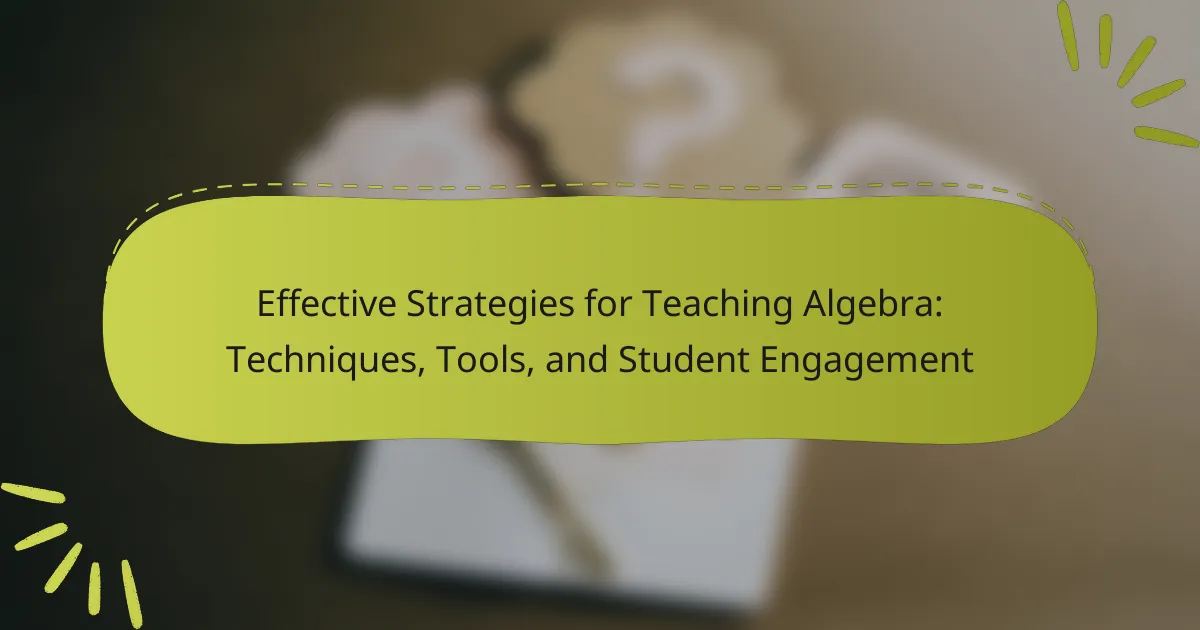Differentiated instruction in mathematics is an educational strategy that customizes teaching methods to accommodate the diverse needs of students, recognizing variations in backgrounds, readiness levels, and learning styles. This approach involves assessing individual student profiles to provide tailored challenges and support, which can enhance student engagement and academic performance. Key strategies include tiered assignments, flexible grouping, and learning centers, all designed to foster collaboration and cater to different skill levels. Research indicates that effective differentiated instruction significantly improves learning outcomes in mathematics, creating a supportive environment where students feel valued and understood.
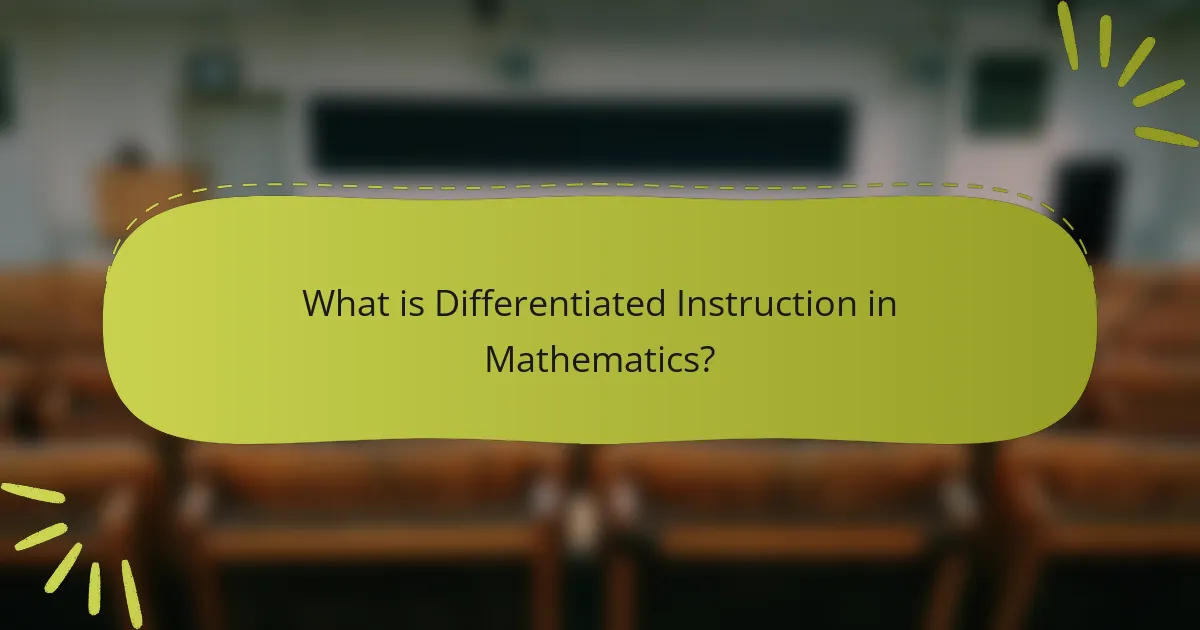
What is Differentiated Instruction in Mathematics?
Differentiated instruction in mathematics is an educational approach that tailors teaching methods to meet diverse student needs. It recognizes that students have varying backgrounds, readiness levels, and learning styles. Teachers assess these differences to provide appropriate challenges and support. This method can involve adjusting content, process, and products based on individual student profiles. Research shows that differentiated instruction can improve student engagement and achievement. According to Tomlinson (2001), effective differentiation leads to better learning outcomes in mathematics.
How does Differentiated Instruction benefit mathematics learning?
Differentiated Instruction benefits mathematics learning by addressing diverse student needs. It allows teachers to tailor lessons based on individual learning styles and paces. This approach fosters a more inclusive classroom environment. Research shows that students engaged in differentiated learning demonstrate improved understanding and retention of mathematical concepts. A study by Tomlinson (2001) highlights that differentiated instruction can lead to higher student achievement in mathematics. By offering varied instructional strategies, such as visual aids or hands-on activities, students can grasp complex ideas more effectively. Overall, Differentiated Instruction enhances student engagement and success in mathematics.
What are the key principles of Differentiated Instruction in mathematics?
The key principles of Differentiated Instruction in mathematics include recognizing student variability, creating a supportive learning environment, and using flexible grouping. Recognizing student variability means acknowledging that learners have different backgrounds, readiness levels, and interests. Creating a supportive learning environment involves fostering a safe space where students feel comfortable taking risks. Using flexible grouping allows teachers to tailor instruction based on students’ needs, enabling collaboration among peers. Additionally, providing multiple means of engagement, representation, and action/expression caters to diverse learning preferences. These principles are supported by research indicating that differentiated instruction can lead to improved student outcomes in mathematics.
How does Differentiated Instruction cater to diverse learning styles?
Differentiated Instruction addresses diverse learning styles by tailoring teaching methods to meet individual student needs. It recognizes that students have varying backgrounds, readiness levels, and interests. Teachers implement strategies such as flexible grouping, varied instructional materials, and multiple assessment methods. These approaches allow students to engage with content in ways that resonate with them. For example, visual learners may benefit from graphic organizers, while auditory learners might prefer discussions. Research by Tomlinson (2001) supports that differentiated strategies enhance student engagement and achievement. Thus, Differentiated Instruction effectively accommodates the unique learning preferences of each student.
What are some common approaches to Differentiated Instruction in Mathematics?
Common approaches to Differentiated Instruction in Mathematics include flexible grouping, tiered assignments, and learning centers. Flexible grouping allows students to work in various configurations based on their needs. This promotes collaboration and peer learning. Tiered assignments provide tasks at varying levels of difficulty. This ensures all students are challenged appropriately. Learning centers offer different activities focusing on specific skills. This allows students to engage with content at their own pace. Additionally, using varied instructional strategies like visual aids and manipulatives supports diverse learning styles. These methods are effective in addressing the diverse needs of students in a mathematics classroom.
How can teachers implement tiered assignments in mathematics?
Teachers can implement tiered assignments in mathematics by designing tasks that cater to varying levels of student readiness. First, they should assess students’ current understanding through pre-tests or observations. Next, they can create assignments that vary in complexity. For example, basic problems can be given to students who need more support. More advanced problems can challenge those who are ready for higher-order thinking.
Teachers should also provide clear instructions and criteria for each tier. This helps students understand expectations and allows them to choose their level of challenge. Regular feedback is essential for guiding student progress. Research shows that tiered assignments can lead to improved student engagement and achievement. According to Tomlinson (2001), differentiated instruction, including tiered assignments, supports diverse learners effectively.
What role does flexible grouping play in Differentiated Instruction?
Flexible grouping is a strategy in Differentiated Instruction that allows teachers to organize students based on their varying needs and learning styles. This approach facilitates targeted instruction and encourages collaboration among peers. By grouping students flexibly, educators can address diverse learning paces and preferences effectively. Research indicates that flexible grouping enhances student engagement and promotes a deeper understanding of mathematical concepts. A study by Tomlinson (2001) highlights that such grouping strategies can lead to improved academic performance and greater student motivation.
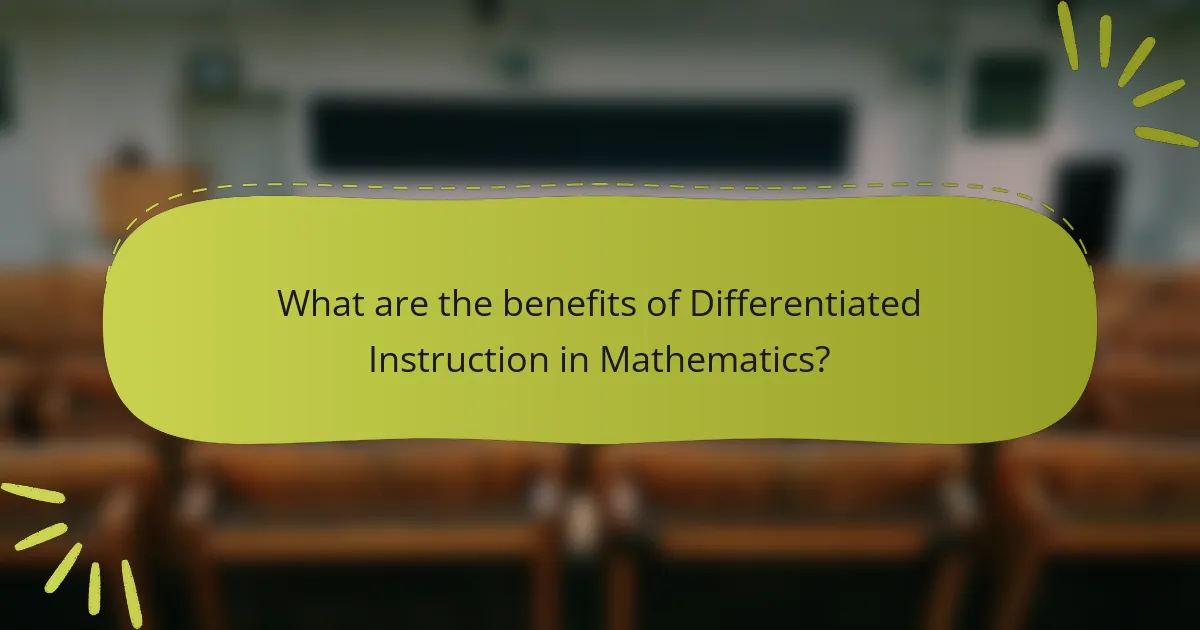
What are the benefits of Differentiated Instruction in Mathematics?
Differentiated instruction in mathematics enhances student engagement and understanding. It tailors teaching methods to meet diverse learning needs. This approach allows for varying levels of complexity in tasks. Students can work at their own pace, increasing motivation. Research shows that differentiated instruction can improve academic performance. A study by Tomlinson (2001) found that students in differentiated classrooms showed greater achievement. Additionally, it fosters a supportive learning environment. Students feel valued and understood, which boosts their confidence. Overall, differentiated instruction effectively addresses individual learning styles and needs in mathematics.
How does Differentiated Instruction improve student engagement in mathematics?
Differentiated Instruction improves student engagement in mathematics by tailoring learning experiences to meet diverse student needs. This approach allows teachers to provide varied instructional methods and materials. Students can learn at their own pace and in their preferred style. For example, visual learners may benefit from graphic organizers, while auditory learners may prefer discussions. Research shows that when instruction is aligned with student interests and readiness, engagement increases. A study by Tomlinson (2001) found that differentiated strategies lead to higher motivation and participation in lessons. Engaged students are more likely to persist in challenging tasks and achieve better outcomes in mathematics.
What impact does Differentiated Instruction have on student achievement?
Differentiated Instruction positively impacts student achievement by tailoring learning experiences to individual needs. This approach acknowledges that students have varied backgrounds, readiness levels, and learning preferences. Research shows that when instruction is differentiated, students demonstrate higher engagement and improved academic performance. For instance, a study by Tomlinson (2001) found that students in differentiated classrooms outperformed their peers in traditional settings. The results indicate that personalized instruction leads to better understanding and retention of material. Overall, the implementation of Differentiated Instruction fosters an inclusive learning environment that enhances student outcomes.
How can Differentiated Instruction promote a growth mindset in mathematics?
Differentiated Instruction can promote a growth mindset in mathematics by tailoring learning experiences to individual student needs. This approach encourages students to engage with mathematical concepts at their own pace. It allows for varied instructional strategies, such as small group work, individualized tasks, and diverse assessment methods.
Research shows that when students receive personalized feedback, they are more likely to embrace challenges. According to a study by Tomlinson (2001), students who experience differentiated instruction demonstrate increased motivation and resilience. These factors contribute to a growth mindset, where students believe that their abilities can improve through effort and learning.
By fostering a supportive learning environment, differentiated instruction helps students view mistakes as opportunities for growth. This perspective is essential for developing a positive attitude towards mathematics. Overall, differentiated instruction effectively cultivates a growth mindset by promoting engagement, resilience, and a positive approach to learning challenges.
What challenges might educators face when implementing Differentiated Instruction?
Educators may face several challenges when implementing Differentiated Instruction. One primary challenge is the diverse learning needs of students. Each student has unique strengths, weaknesses, and learning styles. This variability makes it difficult for educators to tailor instruction effectively. Time constraints also pose a significant challenge. Developing and planning differentiated lessons requires substantial time and effort. Additionally, limited resources can hinder the implementation of varied instructional strategies. Educators may not have access to the necessary materials or technology. Another challenge is classroom management. Managing a classroom with diverse activities can lead to chaos if not handled well. Finally, professional development is crucial. Educators often lack training in differentiated strategies, impacting their confidence and effectiveness. These challenges highlight the complexities of applying Differentiated Instruction in educational settings.
How can educators address the challenges of time management?
Educators can address the challenges of time management by implementing structured lesson plans. Structured lesson plans allow for clear objectives and time allocations. This helps educators stay focused on essential content. Utilizing time-blocking techniques can also enhance productivity. Time-blocking involves dedicating specific time slots for tasks. This method reduces distractions and increases efficiency. Additionally, incorporating technology tools can streamline administrative tasks. Tools like scheduling apps can help manage deadlines effectively. Research shows that organized planning increases teaching effectiveness, leading to better student outcomes.
What strategies can be used to overcome resistance from students or parents?
Building strong relationships with students and parents is essential to overcoming resistance. Establishing trust creates an open line of communication. Involve parents in the learning process by sharing progress and inviting feedback. Offer personalized learning plans that cater to individual student needs. Providing clear explanations of the benefits of differentiated instruction can alleviate concerns. Using data to demonstrate student growth can also foster support. Engaging students with relevant and meaningful content can reduce resistance. Encouraging student voice in decision-making empowers them and addresses their concerns.
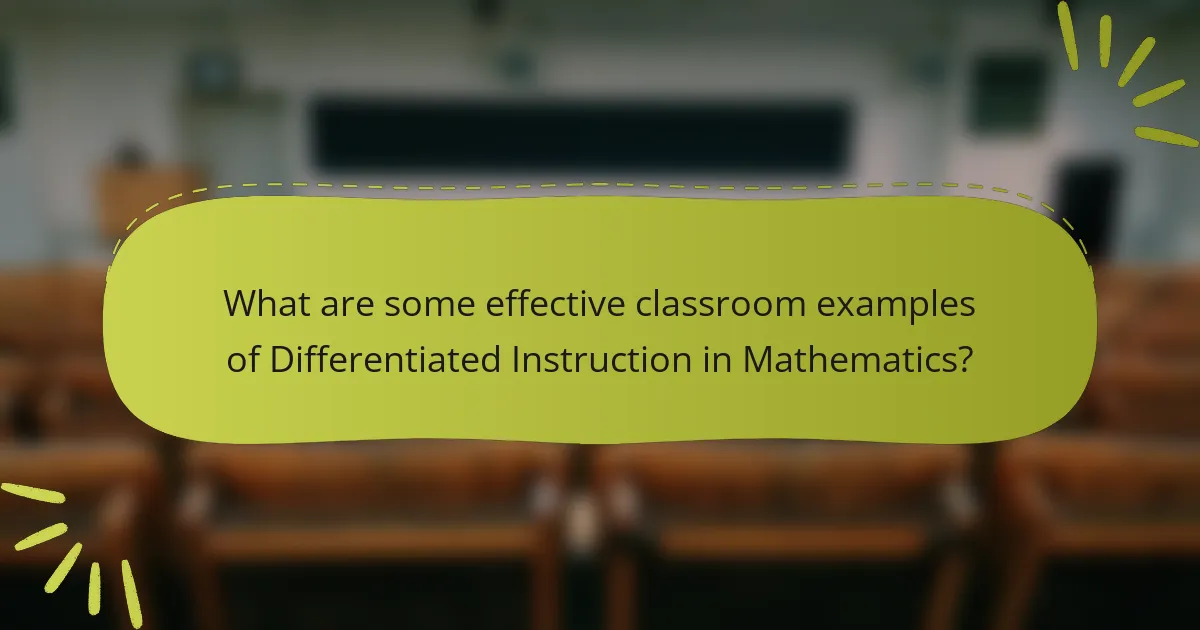
What are some effective classroom examples of Differentiated Instruction in Mathematics?
Effective classroom examples of Differentiated Instruction in Mathematics include tiered assignments, flexible grouping, and learning centers. Tiered assignments allow students to work on tasks at varying levels of complexity. This approach ensures all students are challenged appropriately. Flexible grouping involves changing student groups based on their skill levels or learning styles. This method fosters collaboration and peer learning. Learning centers provide students with different activities that cater to their interests and abilities. These centers can focus on specific skills or concepts in mathematics. Using these strategies can enhance student engagement and understanding in math. Research indicates that differentiated instruction leads to improved student outcomes in mathematics (Tomlinson, 2001).
How can real-world applications be integrated into mathematics lessons?
Real-world applications can be integrated into mathematics lessons by using practical examples that relate to students’ lives. Teachers can incorporate scenarios such as budgeting, shopping, and cooking to teach concepts like addition, subtraction, and fractions. Project-based learning is effective; for instance, students can design a small business and calculate costs and profits. Collaborative activities, such as measuring ingredients for a recipe, engage students and make math tangible. Technology can also play a role; apps and online simulations can demonstrate mathematical concepts in real-world contexts. According to research by the National Council of Teachers of Mathematics, real-world applications enhance student engagement and understanding.
What are some examples of project-based learning in mathematics?
Project-based learning in mathematics includes real-world applications that enhance understanding. One example is a budgeting project where students plan a party. They calculate costs, create budgets, and manage expenses. Another example is a geometry project where students design a park. They apply geometric concepts to create layouts and calculate area. A third example is a statistics project analyzing local data. Students collect data, create surveys, and present findings. These projects engage students and reinforce mathematical concepts through practical experience.
What are best practices for implementing Differentiated Instruction in Mathematics?
Best practices for implementing Differentiated Instruction in Mathematics include assessing student readiness, interests, and learning profiles. Teachers should use formative assessments to identify each student’s current understanding. Flexible grouping is essential; students can work in various configurations based on tasks and goals. Instructional materials should be varied, including visual aids, manipulatives, and technology. Differentiated tasks should be tiered to match different ability levels. Clear learning objectives must be established for all students, ensuring alignment with standards. Ongoing feedback is critical to guide student progress and adjust instruction as needed. Research indicates that these strategies lead to improved student engagement and achievement in mathematics.
How can ongoing assessment inform Differentiated Instruction strategies?
Ongoing assessment can inform Differentiated Instruction strategies by providing real-time data on student understanding. This data helps educators identify individual learning needs and preferences. Teachers can adjust their instructional approaches based on assessment results. For instance, if assessments reveal that some students struggle with specific concepts, teachers can tailor lessons accordingly. Ongoing assessments can include quizzes, observations, and student feedback. Research shows that formative assessments enhance student engagement and learning outcomes. According to the National Council of Teachers of Mathematics, effective use of ongoing assessments leads to improved student performance in mathematics.
What resources are available to support Differentiated Instruction in mathematics?
Resources available to support Differentiated Instruction in mathematics include various educational tools and strategies. These resources encompass differentiated lesson plans, adaptive learning software, and manipulatives. Teacher professional development programs also provide training on effective differentiation techniques. Online platforms like Khan Academy offer personalized learning experiences. Math centers and stations facilitate targeted skill practice. Assessment tools help in identifying student needs and tailoring instruction. Additionally, collaboration with special education staff can enhance differentiation efforts. These resources collectively support diverse learning needs in mathematics education.
Differentiated Instruction in Mathematics is an educational approach that customizes teaching methods to accommodate diverse student needs, including varying backgrounds, readiness levels, and learning styles. The article outlines the benefits of this approach, highlighting improved student engagement and achievement through tailored instructional strategies such as flexible grouping, tiered assignments, and learning centers. Key principles of effective differentiation are discussed, along with common challenges educators face and best practices for implementation. Additionally, the article provides real-world application examples and resources to support differentiated instruction in mathematics education.
